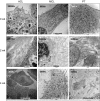Distinctive collagen maturation process in fibroblasts derived from rabbit anterior cruciate ligament, medial collateral ligament, and patellar tendon in vitro
- PMID: 24221246
- PMCID: PMC4555208
- DOI: 10.1007/s00167-013-2773-8
Distinctive collagen maturation process in fibroblasts derived from rabbit anterior cruciate ligament, medial collateral ligament, and patellar tendon in vitro
Abstract
Purpose: Differences in the tissue-specific collagen maturation process between tendon and ligament are still unknown. Collagen cross-link formation is crucial for the collagen maturation process. The aim of this study is to examine collagen maturation processes of anterior cruciate ligament (ACL), medial collateral ligament (MCL), and patellar tendon (PT) in vitro, in order to determine the optimal cell source for tissue engineering of ligament.
Methods: Cells derived from the ACL, MCL, and PT of New Zealand white rabbits were isolated. Each cell type was cultured for up to 4 weeks after reaching confluence. Cell-matrix layers were evaluated and compared for their morphology, collagen cross-links, and gene expression levels of lysine hydroxylase 1 and 2, lysyl oxidase (LOX), tenomodulin, collagen1A1 (Col1A1), and collagen3A1 (Col3A1).
Results: Transmission electron microscopy photomicrographs verified that collagen fibrils were secreted from all three types of fibroblasts. A higher ratio of dihydroxylysinonorleucine/hydroxylysinonorleucine was evident in the ligament compared to the tendon, which was consistent with lysine hydroxylase 2/lysine hydroxylase 1 gene expression. The gene expression of LOX, which regulates the total amount of enzymatic cross-linking, and the gene expression levels of Col1A1 and Col3A1 were higher in the ACL matrix than in the MCL and PT matrices.
Conclusion: ACL, MCL, and PT cells have distinct collagen maturation processes at the cellular level. In addition, the collagen maturation of ACL cells is not necessarily inferior to that of MCL and PT cells in that all three cell types have a good ability to synthesize collagen and induce collagen maturation. This bioactivity of ACL cells in terms of ligament-specific mature collagen induction can be applied to tissue-engineered ACL reconstruction or remnant preserving procedure with ACL reconstruction.
Figures




Similar articles
-
Changes in gene expression of matrix constituents with respect to passage of ligament and tendon fibroblasts.Ann Biomed Eng. 2008 Dec;36(12):1927-33. doi: 10.1007/s10439-008-9565-1. Epub 2008 Sep 19. Ann Biomed Eng. 2008. PMID: 18807189
-
Evaluation of the anterior cruciate ligament, medial collateral ligament, achilles tendon and patellar tendon as cell sources for tissue-engineered ligament.Biomaterials. 2006 May;27(13):2747-54. doi: 10.1016/j.biomaterials.2005.12.013. Epub 2006 Jan 18. Biomaterials. 2006. PMID: 16414115
-
TNF-α induced down-regulation of lysyl oxidase family in anterior cruciate ligament and medial collateral ligament fibroblasts.Knee. 2014 Jan;21(1):47-53. doi: 10.1016/j.knee.2012.12.015. Epub 2013 Mar 11. Knee. 2014. PMID: 23490076
-
Differential expressions of lysyl oxidase family in ACL and MCL fibroblasts after mechanical injury.Injury. 2013 Jul;44(7):893-900. doi: 10.1016/j.injury.2012.08.046. Epub 2012 Sep 23. Injury. 2013. PMID: 23010071
-
Up-regulation expressions of lysyl oxidase family in Anterior Cruciate Ligament and Medial Collateral Ligament fibroblasts induced by Transforming Growth Factor-Beta 1.Int Orthop. 2012 Jan;36(1):207-13. doi: 10.1007/s00264-011-1261-3. Epub 2011 Jun 15. Int Orthop. 2012. PMID: 21674292 Free PMC article.
Cited by
-
In vitro characterization of self-assembled anterior cruciate ligament cell spheroids for ligament tissue engineering.Histochem Cell Biol. 2015 Mar;143(3):289-300. doi: 10.1007/s00418-014-1280-4. Epub 2014 Sep 26. Histochem Cell Biol. 2015. PMID: 25256666
-
Tenogenic modulating insider factor: Systematic assessment on the functions of tenomodulin gene.Gene. 2016 Aug 1;587(1):1-17. doi: 10.1016/j.gene.2016.04.051. Epub 2016 Apr 26. Gene. 2016. PMID: 27129941 Free PMC article. Review.
-
Understanding Fibroblast Heterogeneity in Form and Function.Biomedicines. 2023 Aug 14;11(8):2264. doi: 10.3390/biomedicines11082264. Biomedicines. 2023. PMID: 37626760 Free PMC article. Review.
-
The effects of posterior cruciate ligament rupture on the biomechanical and histological characteristics of the medial collateral ligament: an animal study.J Orthop Surg Res. 2021 May 21;16(1):330. doi: 10.1186/s13018-021-02443-0. J Orthop Surg Res. 2021. PMID: 34020667 Free PMC article.
-
Ligament Alteration in Diabetes Mellitus.J Clin Med. 2022 Sep 27;11(19):5719. doi: 10.3390/jcm11195719. J Clin Med. 2022. PMID: 36233586 Free PMC article. Review.
References
-
- Bolton CW, Bruchman WC. The GORE-TEX expanded polytetrafluoroethylene prosthetic ligament. An in vitro and in vivo evaluation. Clin Orthop Relat Res. 1985;196:202–213. - PubMed
MeSH terms
Substances
LinkOut - more resources
Full Text Sources
Other Literature Sources
Miscellaneous

